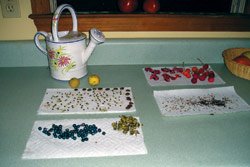I'm feeling a little panicked. It's the end of the garden season at Xpress, and I have so much I want to share in so few words, from seed-gathering to garden clean-up.

First, fall is here, and that means trees, shrubs, wildflowers and such have all fruited and set seed. And that means we can go for a scavenger hunt. How often do you get outside and observe the activity of nature at such a small scale? Now's the time to start honing your observation skills as gardeners.
So grab sandwich baggies and examine the plants in your own backyard. If you must go beyond your own yard and into your neighbor's — and sometimes I must — do it at night with a small flashlight, just in case. Better yet, just ask your neighbors, and promise to share the seeds you gather. Your task is to collect any seeds that capture your fancy. Look at your beech tree, for example. Is that a bud or a seed? (Hint, the buds will be at the terminal ends of the stem, the seeds will be below that.) Don't be shy. Gardening is about experimenting, so be brave and take some risks. If you see a plant you love, collect the seeds and then check reference books or Internet sources on how to store it over winter. If you can't find the information you need, comment online and I'll try to help.
Some seeds require very specific treatment, like hanging out in your refrigerator for three months in a bag of peat moss. Some are not as picky, and all you'll do is put them in your freezer for the winter. Come spring, you'll be ready to plant. Final note: Avoid taking seeds from cultivars or hybrids, as they don't always come back true to type. That is, the new plant won't look like the parent plant. Those plants require cuttings and other methods. But hey, your seed experiment doesn't have to be a total success; gardening is trial and error. Give yourself permission to experiment and fail. So go collect seeds, my favorite fall activity.
Next, let's talk garden clean-up. Fall tasks are crucial to the health of your garden. First, get rid of all unhealthy plants. You don't want those pathogens in the garden next year, so burn them or put them in the trash — not the compost pile, which would then be contaminated. Weed, cut back, and rake up mulch around sensitive plants. And after our first heavy frost, when herbaceous plants have died back, top-dress the garden with a layer of compost or mulch — or both. It's also about time to rake leaves, by the way, and that's quite useful: Organic matter like leaves will help protect plants in winter, and in spring when temperatures rise, those leaves will start breaking down, adding health to your soil.
What about sowing fall veggies? Unfortunately, mid-October is already past the time for seeds to germinate outdoors in Western North Carolina, and it's a little late for most transplants. Days are getting shorter, night temperatures are getting cooler and plants are starting to think dormancy. And we're right on the verge of the first fall frost date, Oct.15 (give or take a few days). If you wanted Brussels sprouts in December, you should have planted them in mid-summer so they'd keep producing way past frost. Fall spinach needed to go in the ground in early August. So plan ahead for next year — unless you have a greenhouse or cold frame. (See Jeff Ashton's "The Dirt: Salad Days," Oct. 1, 2008, Xpress.)
Next question: Is it time to order plants for next year? Take your time this winter to peruse your gardening catalogues and dream. Order seeds and plants in February — January, if you're afraid they'll be out of stock.
Finally winter gardening: Some plants prefer winter, and bloom nicely in January — winter jasmine with its lovely yellow flowers and witch hazel with those brilliant sulfur colored blooms. The smaller blooms of the Lenten rose survive snow piling up on them. When planning your garden, don't forget the winter season. Dogwood trees, with their gnarly, arching limbs, have a great architecture, adding visual effects in winter. Acer griseum has amazing cinnamon-colored, exfoliating bark that's gorgeous against the snow. Astillibe blooms are worth leaving in the winter garden, where they'll dry in place. Don't cut back them back; instead, let them stand out against the backdrop of winter. Evergreens give us the green we long to see, and the best winter gardening activities are providing for wildlife. Holly berries feed the birds, trees and shrubs provide shelter against the cold and predators.
Consider all this as you plant; it's a four-season garden. So while The Dirt may be packing away the garden tools, your garden keeps going.
For garden news through late fall and winter, visit www.mountainx.com/garden.
[Cinthia Milner lives in Leicester.]



exfoliating bark that’s gorgeous against the snow. Astillibe blooms are worth leaving in the winter garden, where they’ll dry in place. Don’t cut back them back; instead, let them stand out against the backdrop of winter.